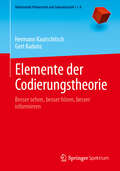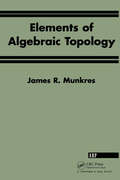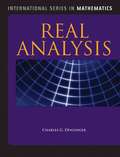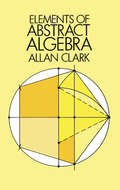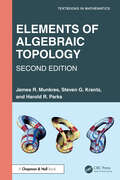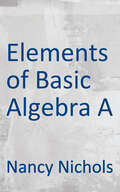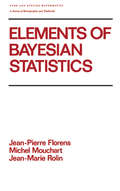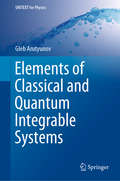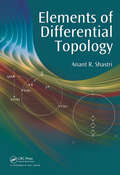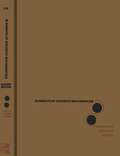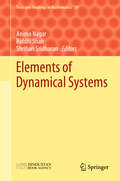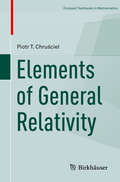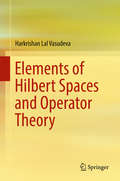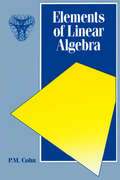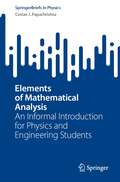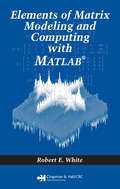- Table View
- List View
Elemente der Codierungstheorie: Besser sehen, besser hören, besser informieren (Mathematik Primarstufe und Sekundarstufe I + II)
by Gert Kadunz Hermann KautschitschIm täglichen Leben sind wir zunehmend von Codes umgeben, die mathematisch konstruiert werden. Sie sind teils leicht erkennbar (Strichcode, ISBN, IBAN, QR) und teils eher verborgen (GPS, WLAN, CD, DVD). In diesem Buch werden solche Codes vorgestellt. Es wird dargelegt, wie sie aufgebaut sind, wie sie funktionieren und welche Mathematik zu ihrer Entwicklung und Anwendung notwendig ist. Die Lesenden lernen, eigenhändig Codes zu erstellen, Fehler zu erkennen und zu korrigieren:EAN, ISBN und deren Barcodedarstellung sowie die internationale Bankkontonummer IBAN werden erarbeitet.Kleine QR-Codes werden mit den vorgestellten Methoden (Paritätsprüfung, Linearcode, Polynomcode, zyklischer Code und Reed-Solomon Code) anschaulich realisiert.An der Herstellung einer Mini-CD mit einem CIRC-Code über einem kleinen Körper werden wesentliche Konstruktionsprinzipien von neuen Codes aus bestehenden Codes, wie z.B. Kürzen, Erweitern, Spreizen (Interleaving) und gekreuztes Spreizen (Cross-Interleaving) veranschaulicht.Das Verstehen von Mathematik wird durch diese selbstständige Erstellung und Verwendung didaktisch maßgeschneiderter Codes wesentlich gefördert.Ein besonderer Fokus des Buchs liegt auf elementaren Methoden des Rechnens mit ganzen Zahlen und Polynomen. Für diese benötigt man nur den Satz von der Division mit Rest als zentrale Aussage – daher können große Abschnitte bereits mit Lernenden der Sekundarstufe II erarbeitet und die Grundlagen wesentlicher Teile der Codierungstheorie von den Lernenden mathematisch korrekt erfasst werden. Für Ausführungen, zu deren Verständnis Kenntnisse notwendig sind, die über die Mathematik der Sekundarstufe II hinausgehen, liegt ein ausführlicher Anhang vor (Vektorräume, Matrizen, Rechnen in endlichen Körpern).
Elements Of Algebraic Topology
by James R. MunkresElements of Algebraic Topology provides the most concrete approach to the subject. With coverage of homology and cohomology theory, universal coefficient theorems, Kunneth theorem, duality in manifolds, and applications to classical theorems of point-set topology, this book is perfect for comunicating complex topics and the fun nature of algebraic topology for beginners.
Elements Of Real Analysis (G - Reference, Information And Interdisciplinary Subjects)
by Charles G. DenlingerElementary Real Analysis is a core course in nearly all mathematics departments throughout the world. It enables students to develop a deep understanding of the key concepts of calculus from a mature perspective. Elements of Real Analysis is a student-friendly guide to learning all the important ideas of elementary real analysis, based on the author's many years of experience teaching the subject to typical undergraduate mathematics majors. It avoids the compact style of professional mathematics writing, in favor of a style that feels more comfortable to students encountering the subject for the first time. It presents topics in ways that are most easily understood, without sacrificing rigor or coverage. In using this book, students discover that real analysis is completely deducible from the axioms of the real number system. They learn the powerful techniques of limits of sequences as the primary entry to the concepts of analysis, and see the ubiquitous role sequences play in virtually all later topics. They become comfortable with topological ideas, and see how these concepts help unify the subject. Students encounter many interesting examples, including "pathological" ones, that motivate the subject and help fix the concepts. They develop a unified understanding of limits, continuity, differentiability, Riemann integrability, and infinite series of numbers and functions.
Elements of Abstract Algebra
by Allan ClarkThis concise, readable, college-level text treats basic abstract algebra in remarkable depth and detail. An antidote to the usual surveys of structure, the book presents group theory, Galois theory, and classical ideal theory in a framework emphasizing proof of important theorems.Chapter I (Set Theory) covers the basics of sets. Chapter II (Group Theory) is a rigorous introduction to groups. It contains all the results needed for Galois theory as well as the Sylow theorems, the Jordan-Holder theorem, and a complete treatment of the simplicity of alternating groups. Chapter III (Field Theory) reviews linear algebra and introduces fields as a prelude to Galois theory. In addition there is a full discussion of the constructibility of regular polygons. Chapter IV (Galois Theory) gives a thorough treatment of this classical topic, including a detailed presentation of the solvability of equations in radicals that actually includes solutions of equations of degree 3 and 4 - a feature omitted from all texts of the last 40 years. Chapter V (Ring Theory) contains basic information about rings and unique factorization to set the stage for classical ideal theory. Chapter VI (Classical Ideal Theory) ends with an elementary proof of the Fundamental Theorem of Algebraic Number Theory for the special case of Galois extensions of the rational field, a result which brings together all the major themes of the book.The writing is clear and careful throughout, and includes many historical notes. Mathematical proof is emphasized. The text comprises 198 articles ranging in length from a paragraph to a page or two, pitched at a level that encourages careful reading. Most articles are accompanied by exercises, varying in level from the simple to the difficult.
Elements of Accounts Part 1 class 12 - GSTB
by Gujarat State Board of School TextbooksThe Gujarat State Board of School Textbooks takes pleasure in presenting this textbook to the students. It is prepared according to the new syllabus of Elements of Accounts (Part 1) for Standard 12. This textbook is written and reviewed by expert teachers and professors. This textbook is published after incorporating the necessary changes suggested by the reviewers.
Elements of Accounts Part 2 class 12 - GSTB
by Gujarat Sate Board of School TextbooksThe book published by the Gujarat State Board of Textbooks for class 12 has been written in a simple English language keeping in view the standard of class 12 students. This book will also be of great use to those students who are just beginning to learn the subject of Accountancy. A number of illustrations have been given in each chapter and these have been solved in such a simple manner that students can easily understand them. Practical questions given at the end of each chapter are strictly in the serial order of the illustrations. Answers and hints to solve the questions have been given at the end of each question. We are very much confident that after doing the illustrations, students can themselves solve the practical questions. The book contains essay-type, short-anwer type, objective type and practical questions at the end of each chapter so that students may test their understanding of the chapter.
Elements of Algebraic Coding Theory
by Lekh R. VermaniCoding theory came into existence in the late 1940s and is concerned with devising efficient encoding and decoding procedures.The book is intended as a principal text for first courses in coding and algebraic coding theory, and is aimed at advanced undergraduates and recent graduates as both a course and self-study text. BCH and cyclic, Group codes, Hamming codes, polynomial as well as many other codes are introduced in this textbook. Incorporating numerous worked examples and complete logical proofs, it is an ideal introduction to the fundamental of algebraic coding.
Elements of Algebraic Topology (Textbooks in Mathematics)
by Harold R. Parks James R. Munkres Steven G. KrantzThis classic text appears here in a new edition for the first time in four decades. The new edition, with the aid of two new authors, brings it up to date for a new generation of mathematicians and mathematics students.Elements of Algebraic Topology provides the most concrete approach to the subject. With coverage of homology and cohomology theory, universal coefficient theorems, Kunneth theorem, duality in manifolds, and applications to classical theorems of point-set topology, this book is perfect for communicating complex topics and the fun nature of algebraic topology for beginners.This second edition retains the essential features of the original book. Most of the notation and terminology are the same. There are some useful additions. There is a new introduction to homotopy theory. A new Index of Notation is included. Many new exercises are added.Algebraic topology is a cornerstone of modern mathematics. Every working mathematician should have at least an acquaintance with the subject. This book, which is based largely on the theory of triangulations, provides such an introduction. It should be accessible to a broad cross-section of the profession—both students and senior mathematicians. Students should have some familiarity with general topology.
Elements of Bayesian Statistics
by Jean-Pierre FlorensThe ingratiating title notwithstanding, this is in no standard sense a text but a monograph, based largely upon the authors' research over a period of years, and intended to be read by sophisticated students of theoretical statistics.
Elements of Classical and Quantum Integrable Systems (UNITEXT for Physics)
by Gleb ArutyunovIntegrable models have a fascinating history with many important discoveries that dates back to the famous Kepler problem of planetary motion. Nowadays it is well recognised that integrable systems play a ubiquitous role in many research areas ranging from quantum field theory, string theory, solvable models of statistical mechanics, black hole physics, quantum chaos and the AdS/CFT correspondence, to pure mathematics, such as representation theory, harmonic analysis, random matrix theory and complex geometry. Starting with the Liouville theorem and finite-dimensional integrable models, this book covers the basic concepts of integrability including elements of the modern geometric approach based on Poisson reduction, classical and quantum factorised scattering and various incarnations of the Bethe Ansatz. Applications of integrability methods are illustrated in vast detail on the concrete examples of the Calogero-Moser-Sutherland and Ruijsenaars-Schneider models, the Heisenberg spin chain and the one-dimensional Bose gas interacting via a delta-function potential. This book has intermediate and advanced topics with details to make them clearly comprehensible.
Elements of Compiler Design
by Alexander MedunaMaintaining a balance between a theoretical and practical approach to this important subject, Elements of Compiler Design serves as an introduction to compiler writing for undergraduate students. From a theoretical viewpoint, it introduces rudimental models, such as automata and grammars, that underlie compilation and its essential phases. Based on
Elements of Concave Analysis and Applications
by Prem K. KytheConcave analysis deals mainly with concave and quasi-concave functions, although convex and quasi-convex functions are considered because of their mutual inherent relationship. The aim of Elements of Concave Analysis and Applications is to provide a basic and self‐contained introduction to concepts and detailed study of concave and convex functions. It is written in the style of a textbook, designed for courses in mathematical economics, finance, and manufacturing design. The suggested prerequisites are multivariate calculus, ordinary and elementary PDEs, and elementary probability theory.
Elements of Differential Topology
by Anant R. ShastriDerived from the author's course on the subject, Elements of Differential Topology explores the vast and elegant theories in topology developed by Morse, Thom, Smale, Whitney, Milnor, and others. It begins with differential and integral calculus, leads you through the intricacies of manifold theory, and concludes with discussions on algebraic topol
Elements of Discrete Mathematics - Second Edition
by C L LiuElements of Discrete Mathematics, Second Edition" by C. L. Liu is a comprehensive and accessible textbook that explores fundamental concepts in discrete mathematics. The book covers topics such as logic, set theory, combinatorics, graph theory, and mathematical induction, providing a solid foundation for students studying computer science, engineering, or mathematics. The author emphasizes clear explanations and examples to help readers grasp abstract concepts, making it suitable for both beginners and those seeking a deeper understanding of the subject. With its practical applications in computer science and information technology, the book serves as an essential resource for students and professionals alike, fostering a strong understanding of discrete mathematical structures and their significance in various disciplines.
Elements of Dynamical Systems (Texts and Readings in Mathematics #79)
by Anima Nagar Riddhi Shah Shrihari SridharanThis book stems from lectures that were delivered at the three-week Advanced Instructional School on Ergodic Theory and Dynamical Systems held at the Indian Institute of Technology Delhi, from 4–23 December 2017, with the support of the National Centre for Mathematics, National Board for Higher Mathematics, Department of Atomic Energy, Government of India. The book discusses various aspects of dynamical systems. Each chapter of this book specializes in one aspect of dynamical systems and thus begins at an elementary level and goes on to cover fairly advanced material. The book helps researchers be familiar with and navigate through different parts of ergodic theory and dynamical systems.
Elements of General Relativity (Compact Textbooks in Mathematics)
by Piotr T. ChruścielThis book provides an introduction to the mathematics and physics of general relativity, its basic physical concepts, its observational implications, and the new insights obtained into the nature of space-time and the structure of the universe. It introduces some of the most striking aspects of Einstein's theory of gravitation: black holes, gravitational waves, stellar models, and cosmology. It contains a self-contained introduction to tensor calculus and Riemannian geometry, using in parallel the language of modern differential geometry and the coordinate notation, more familiar to physicists. The author has strived to achieve mathematical rigour, with all notions given careful mathematical meaning, while trying to maintain the formalism to the minimum fit-for-purpose. Familiarity with special relativity is assumed. The overall aim is to convey some of the main physical and geometrical properties of Einstein's theory of gravitation, providing a solid entry point to further studies of the mathematics and physics of Einstein equations.
Elements of Hilbert Spaces and Operator Theory
by Harkrishan Lal VasudevaThe book presents an introduction to the geometry of Hilbert spaces and operator theory, targeting graduate and senior undergraduate students of mathematics. Major topics discussed in the book are inner product spaces, linear operators, spectral theory and special classes of operators, and Banach spaces. On vector spaces, the structure of inner product is imposed. After discussing geometry of Hilbert spaces, its applications to diverse branches of mathematics have been studied. Along the way are introduced orthogonal polynomials and their use in Fourier series and approximations. Spectrum of an operator is the key to the understanding of the operator. Properties of the spectrum of different classes of operators, such as normal operators, self-adjoint operators, unitaries, isometries and compact operators have been discussed. A large number of examples of operators, along with their spectrum and its splitting into point spectrum, continuous spectrum, residual spectrum, approximate point spectrum and compression spectrum, have been worked out. Spectral theorems for self-adjoint operators, and normal operators, follow the spectral theorem for compact normal operators. The book also discusses invariant subspaces with special attention to the Volterra operator and unbounded operators. In order to make the text as accessible as possible, motivation for the topics is introduced and a greater amount of explanation than is usually found in standard texts on the subject is provided. The abstract theory in the book is supplemented with concrete examples. It is expected that these features will help the reader get a good grasp of the topics discussed. Hints and solutions to all the problems are collected at the end of the book. Additional features are introduced in the book when it becomes imperative. This spirit is kept alive throughout the book.
Elements of Linear Algebra (Chapman Hall/crc Mathematics Ser. #8)
by P.M. CohnThis volume presents a thorough discussion of systems of linear equations and their solutions. Vectors and matrices are introduced as required and an account of determinants is given. Great emphasis has been placed on keeping the presentation as simple as possible, with many illustrative examples. While all mathematical assertions are proved, the student is led to view the mathematical content intuitively, as an aid to understanding.The text treats the coordinate geometry of lines, planes and quadrics, provides a natural application for linear algebra and at the same time furnished a geometrical interpretation to illustrate the algebraic concepts.
Elements of Logical Reasoning
by Aptara. Inc Jan Von PlatoSome of our earliest experiences of the conclusive force of an argument come from school mathematics: faced with a mathematical proof, we cannot deny the conclusion once the premises have been accepted. Behind such arguments lies a more general pattern of 'demonstrative arguments' that is studied in the science of logic. Logical reasoning is applied at all levels, from everyday life to advanced sciences, and a remarkable level of complexity is achieved in everyday logical reasoning, even if the principles behind it remain intuitive. Jan von Plato provides an accessible but rigorous introduction to an important aspect of contemporary logic: its deductive machinery. He shows that when the forms of logical reasoning are analysed, it turns out that a limited set of first principles can represent any logical argument. His book will be valuable for students of logic, mathematics and computer science.
Elements of Mathematical Analysis: An Informal Introduction for Physics and Engineering Students (SpringerBriefs in Physics)
by Costas J. PapachristouThis book provides a comprehensive yet informal introduction to differentiating and integrating real functions with one variable. It also covers basic first-order differential equations and introduces higher-dimensional differentiation and integration. The focus is on significant theoretical proofs, accompanied by illustrative examples for clarity. A comprehensive bibliography aids deeper understanding. The concept of a function's differential is a central theme, relating to the "differential" within integrals. The discussion of indefinite integrals (collections of antiderivatives) precedes definite integrals, naturally connecting the two. The Appendix offers essential math formulas, exercise properties, and an in-depth exploration of continuity and differentiability. Select exercise solutions are provided. This book suits short introductory math courses for novice physics/engineering students. It equips them with vital differential and integral calculus tools for real-world applications. It is also useful for first-year undergraduates, reinforcing advanced calculus foundations for better Physics comprehension.
Elements of Mathematical Methods for Physics
by Francis E. MensahElements of Mathematical Methods for Physics provides students with an approachable and innovative introduction to key concepts of mathematical physics, accompanied by clear and concise explanations, relevant real-world examples and problems that help them to master the fundamentals of mathematical physics. The topics are presented at a basic level, for students lacking a prior mathematical background.This book is designed to be covered in two semesters, presenting 18 chapters on topics varying from differential equations, matrix algebra and tensor analysis to Fourier transform, including special functions and dynamical systems.Upper-level undergraduate and graduate students of physics and engineering as well as professionals will gain a better grip of the basics and a deeper insight into and appreciation for mathematical methods for physics.Key Features:• Reviews and presents the basic math skills needed at the undergraduate level.• Chapters accompanied by examples and end-of-chapter problems to enhance understanding.• Introduces dynamical systems and includes a chapter on Hilbert Space
Elements of Mathematics for Economics and Finance (Classroom Companion: Economics)
by Vassilis C. Mavron Timothy N. PhillipsThis book equips undergraduates with the mathematical skills required for degree courses in economics, finance, management, and business studies. The fundamental ideas are described in the simplest mathematical terms, highlighting threads of common mathematical theory in the various topics. Coverage helps readers become confident and competent in the use of mathematical tools and techniques that can be applied to a range of problems.
Elements of Matrix Modeling and Computing with MATLAB
by Robert E. WhiteAs discrete models and computing have become more common, there is a need to study matrix computation and numerical linear algebra. Encompassing a diverse mathematical core, Elements of Matrix Modeling and Computing with MATLAB examines a variety of applications and their modeling processes, showing you how to develop matrix models and solve algebr
